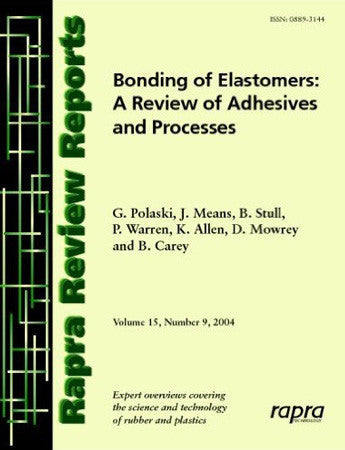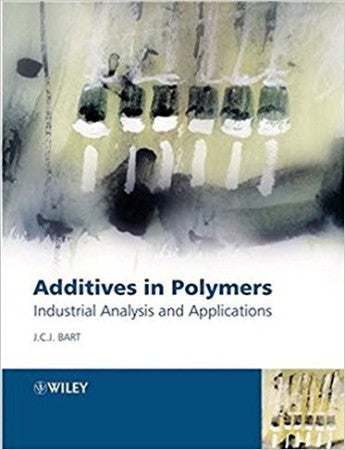Bonding Elastomers: A Review of Adhesives and Processes
This review has been written as a practical approach to bonding various kinds of elastomers to substrates such as steel and plastics, as used in the manufacture of diverse products such as rubber covered rolls, urethane fork lift wheels, rubber lining for chemical storage or solid rocket motors, engine bushes and mounts, seals for transmissions, electrical power connectors and military tank track pads.
There are over 20 kinds of elastomeric polymer each having unique physical and chemical resistance characteristics. Through compounding, a given elastomer’s performance can be enhanced but no single elastomer can be compounded to meet all applications. In the same manner, no single adhesive can provide the needed levels of adhesion and environmental resistance to all polymers. Even when bonding a particular elastomer, the adhesive of choice can vary depending upon the compounding of the rubber including the cure system, the environmental application of the bonded assembly, the substrate to which the rubber is going to be bonded, the moulding method and the geometry of the part. Other factors affecting adhesive selection might include colour, conductivity, and means of application.
This review is based on the authors' years of experience working closely with end-use customers and offers a thorough overview of how to successfully bond rubber to a given substrate in the manufacture of quality rubber engineered components:
substrate preparation selection of adhesive adhesive preparation adhesive application moulding conditions testing and bond failure analysis future trends
This review of rubber mixing is supported by an indexed section containing several hundred key references and abstracts selected from the Rapra Abstracts database.
There are over 20 kinds of elastomeric polymer each having unique physical and chemical resistance characteristics. Through compounding, a given elastomer’s performance can be enhanced but no single elastomer can be compounded to meet all applications. In the same manner, no single adhesive can provide the needed levels of adhesion and environmental resistance to all polymers. Even when bonding a particular elastomer, the adhesive of choice can vary depending upon the compounding of the rubber including the cure system, the environmental application of the bonded assembly, the substrate to which the rubber is going to be bonded, the moulding method and the geometry of the part. Other factors affecting adhesive selection might include colour, conductivity, and means of application.
This review is based on the authors' years of experience working closely with end-use customers and offers a thorough overview of how to successfully bond rubber to a given substrate in the manufacture of quality rubber engineered components:
substrate preparation selection of adhesive adhesive preparation adhesive application moulding conditions testing and bond failure analysis future trends
This review of rubber mixing is supported by an indexed section containing several hundred key references and abstracts selected from the Rapra Abstracts database.
1 Forward
2 Introduction
2.1 The Process
2.2 Primers
2.3 Adhesives
2.4 Environmental Concerns
3 Adhesive Application
3.1 Surface Preparation
3.2 Adhesive Selection
3.3 Adhesive Preparation
3.4 Adhesive Application
3.5 Film Thickness
3.6 Drying
3.7 Storage
4 Moulding
4.1 Methods of Mould Bonding
4.2 Sweeping (Flow)
4.3 Pre-bake Resistance
4.4 Mould Release
4.5 Demoulding
5 Environmentally Preferred Adhesives
5.1 Adhesive Description
5.2 Formulations
5.3 Application
5.4 Rubber Formulations
5.5 Testing
5.5.1 Bond Performance
5.5.2 Primary Adhesion
5.5.3 Sweep
5.5.4 Hot Tear
5.5.5 Salt Spray
5.6 Results
5.7 Summary
6 Aqueous Adhesives
6.1 Aqueous versus Solvent Based Adhesives
6.2 Experimental
6.3 Results and Discussion
6.4 Summary
7 Troubleshooting
7.1 Types of Failures
7.1.1 Rubber Failure
7.1.2 Rubber-to-Cement (RC) Failure
7.1.3 Cement-to Metal (CM) Failure
7.1.4 Other Failures
7.2 Failure Analysis
7.2.1 Rubber-to-Cement (RC) Failure
7.2.2 Cement-to-Metal Failure
7.3 Surface Analysis Techniques
7.4 Root Cause
7.5 Summary
8 Testing
9 Markets
9.1 Bonding Rubber Rolls
9.1.1 Core Preparation
9.1.2 The Adhesive System Selection Process
9.1.3 Handling, Mixing, and Application Processes
9.1.4 Rubber Lay-Up and Curing
9.1.5 Troubleshooting
9.2 Bonding Urethane's
9.2.1 Bonding Applications
9.2.2 Adhesive System Selection
9.2.3 Adhesive Application
9.3 Thermoplastic Elastomer Bonding
9.3.1 Bonding Applications
9.3.2 Bonding Methods
9.3.3 Adhesive Selection (for Use in Injection Moulding)
9.3.4 Application
9.3.5 Pre-Baking Adhesive Coated Parts Prior to Moulding
9.3.6 Injection Moulding
9.3.7 Checking Bond Adhesion
9.3.8 Bond Performance
9.4 Rubber Lining
9.4.1 Surface Preparation
9.4.2 Rubber Lining
9.4.3 Rubber and the Cure System
9.4.4 Primers/Adhesives/Tack Coats
9.4.5 Adhesive Handling
9.4.6 Application
9.4.7 Quality Control
9.4.8 Summary
9.5 Adhesives for Seals and Gaskets
9.5.1 Adhesive and Coating Selections
9.5.2 Summary
9.6 Adhesives for Automotive Weatherstripping
9.6.1 Metal Profile Carriers
9.6.2 Elastomeric Sealing Surfaces
9.6.3 Extrusion Process
9.6.4 Performance Testing
9.6.5 Summary
10 Future Trends in Rubber-to-Metal Bonding
Abbreviations
Abstracts from the Polymer Library Database
Subject Index
Company Index
2 Introduction
2.1 The Process
2.2 Primers
2.3 Adhesives
2.4 Environmental Concerns
3 Adhesive Application
3.1 Surface Preparation
3.2 Adhesive Selection
3.3 Adhesive Preparation
3.4 Adhesive Application
3.5 Film Thickness
3.6 Drying
3.7 Storage
4 Moulding
4.1 Methods of Mould Bonding
4.2 Sweeping (Flow)
4.3 Pre-bake Resistance
4.4 Mould Release
4.5 Demoulding
5 Environmentally Preferred Adhesives
5.1 Adhesive Description
5.2 Formulations
5.3 Application
5.4 Rubber Formulations
5.5 Testing
5.5.1 Bond Performance
5.5.2 Primary Adhesion
5.5.3 Sweep
5.5.4 Hot Tear
5.5.5 Salt Spray
5.6 Results
5.7 Summary
6 Aqueous Adhesives
6.1 Aqueous versus Solvent Based Adhesives
6.2 Experimental
6.3 Results and Discussion
6.4 Summary
7 Troubleshooting
7.1 Types of Failures
7.1.1 Rubber Failure
7.1.2 Rubber-to-Cement (RC) Failure
7.1.3 Cement-to Metal (CM) Failure
7.1.4 Other Failures
7.2 Failure Analysis
7.2.1 Rubber-to-Cement (RC) Failure
7.2.2 Cement-to-Metal Failure
7.3 Surface Analysis Techniques
7.4 Root Cause
7.5 Summary
8 Testing
9 Markets
9.1 Bonding Rubber Rolls
9.1.1 Core Preparation
9.1.2 The Adhesive System Selection Process
9.1.3 Handling, Mixing, and Application Processes
9.1.4 Rubber Lay-Up and Curing
9.1.5 Troubleshooting
9.2 Bonding Urethane's
9.2.1 Bonding Applications
9.2.2 Adhesive System Selection
9.2.3 Adhesive Application
9.3 Thermoplastic Elastomer Bonding
9.3.1 Bonding Applications
9.3.2 Bonding Methods
9.3.3 Adhesive Selection (for Use in Injection Moulding)
9.3.4 Application
9.3.5 Pre-Baking Adhesive Coated Parts Prior to Moulding
9.3.6 Injection Moulding
9.3.7 Checking Bond Adhesion
9.3.8 Bond Performance
9.4 Rubber Lining
9.4.1 Surface Preparation
9.4.2 Rubber Lining
9.4.3 Rubber and the Cure System
9.4.4 Primers/Adhesives/Tack Coats
9.4.5 Adhesive Handling
9.4.6 Application
9.4.7 Quality Control
9.4.8 Summary
9.5 Adhesives for Seals and Gaskets
9.5.1 Adhesive and Coating Selections
9.5.2 Summary
9.6 Adhesives for Automotive Weatherstripping
9.6.1 Metal Profile Carriers
9.6.2 Elastomeric Sealing Surfaces
9.6.3 Extrusion Process
9.6.4 Performance Testing
9.6.5 Summary
10 Future Trends in Rubber-to-Metal Bonding
Abbreviations
Abstracts from the Polymer Library Database
Subject Index
Company Index




